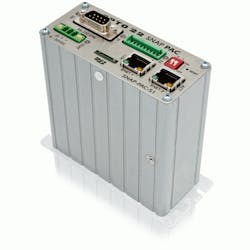Controllers Adapt to a Changing Industry
These are exciting times in the industrial automation industry. After decades of incremental technology evolution, we’re now in the midst of a rapid-fire release of new products featuring technologies and approaches that are very new to the industrial realm. The most recent example of this is Opto 22’s release of a RESTful API (application programming interface) and server for its industrial programmable automation controllers (PACs).
The purpose of using RESTful APIs in industry is to bridge the communication disconnect between the physical electrical signals industrial assets use and the digital systems of the Internet. The common way of bridging this gap today is via gateways and middleware. Opto 22 says that adding a RESTful server and API to its PACs enables secure access to legacy physical assets, while minimizing the integration time and cost associated with Industrial Internet of Things (IIoT) application development by eliminating the need for protocol converters, gateways and middleware.
RESTful APIs operate by using HTTP—the communication protocol of the Internet—to break down software interactions into simple steps. Sites such as Google, Amazon, Twitter and LinkedIn use it widely. Opto 22’s incorporation of a RESTful server and API into a PAC is reportedly the first commercially available instance of this marriage of technologies.
To learn more about this, I spoke with Matt Newton, Opto 22’s director of technical marketing. One of the main things I wanted to know is: What type of user is a RESTful-enabled PAC really designed for—OEMs and their system developers, IT professionals or industrial end users?
“Manufacturing operations personnel can use the PAC’s RESTful API to transfer data from their real-world manufacturing assets directly into IT systems like databases and the cloud without having to use protocol converters, OPC servers or gateways,” Newton said. “IT professionals can use the development tools of their choice—any JSON-compatible language and any system—to develop software applications for manufacturing, asset utilization, predictive maintenance, reporting, and more. OEMs and machine builders no longer need to worry about drivers, converters or licenses to connect their machines to IT systems. By adding the RESTful API to PACs, all of these legacy tools for converting real-world machine data into the format IT systems understand are a thing of the past.”
While RESTful creates easier methods of data transfer, Newton stressed the importance of understanding that “the RESTful API and RESTful server on SNAP PAC controllers don't replace existing methods for exchanging data. All other methods continue to be fully supported, including EtherNet/IP, Modbus TCP, OptoMMP, OPC, and more. All data exchange methods can be used simultaneously. For example, the PAC could be responding to requests from an OPC server, Modbus TCP master, and from an API-driven application all at once. And each may be for a different task or project, providing more levels of data flexibility than ever before.”
The ultimate point, according to Newton, is “getting data into IT systems where we have massive computer processing power and data storage that allow us to do amazing things with that data. It’s not so much about how each group will use the technology to benefit the specific business processes for which they’re responsible. The goal with this technology is to more closely align the enterprise’s OT and IT teams to streamline access to and analysis of vast volumes of data that was previously inaccessible.”
Newton also pointed out that it’s not necessary to buy a new PAC from Opto 22 to get the benefits of RESTful. “The RESTful server can be added to any existing Opto 22 PAC controller dating back to 2007,” he said. “A user only needs to update the firmware on their controllers to access these new features. And all firmware updates are free of charge.”
He added that a RESTful server and API are now standard features in “all PACs we ship today. There’s no need to buy additional hardware or software products; the features are built directly into the controller's firmware.”
About the Author
David Greenfield, editor in chief
Editor in Chief

Leaders relevant to this article:
